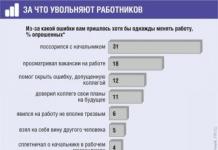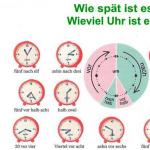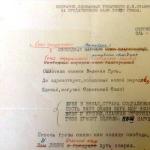The provisions of the regulations establish the possibility for an employee to be given a vacation period by the company administration before terminating his employment contract if he has previously unused days. The employee can use this time in whole or in part. Therefore, the management of the enterprise must know how to properly arrange leave with subsequent dismissal.
The right to leave is established by government agencies through regulations. If an employee is employed under an employment agreement in a company, then a certain number of vacation days are due for the period worked.
At the same time, for the first time, an employee has the opportunity to go on annual paid leave in accordance with the law after six months of work.
In the future, the employee receives the right to use his days of rest only in accordance with that approved by the enterprise. This plan must be followed by both the employee and the company administration.
If an employee decides to terminate the employment contract, then he will be able to receive leave followed by dismissal at his own request only under two factors:
- If the company management agrees to this.
- If at the time of dismissal the employee did not take his allotted vacation. This is determined by a HR specialist according to the rule: for each month of work, an employee is entitled to 2.33 days of vacation. It is also necessary to take into account the rest periods previously provided to him.
If the administration refuses to provide leave, the resigning employee is entitled only to receive monetary compensation. That is, an employee can submit documents to receive annual paid leave when leaving, but management has the right to disagree.
Attention! Therefore, the provision of rest with further dismissal can be carried out only when it occurs, in agreement with the employer, or on the basis of an agreement concluded between the parties.
In the first case, it is recommended to draw up a written agreement between the employee and management to avoid problems in the future. If the initiative to terminate comes from management, such a period cannot be granted.
According to regulations of labor law or by virtue of a concluded employment contract, an employee may be granted additional leave. It is subject to the current rules regarding the main period.
The employee will be able to use the leave with the consent of management even if it expires when its use for the period exceeds the term of the contract.
Features of leave followed by dismissal in 2019
Do I need to work 2 weeks in this case? No. With the consent of the administration, the employee can leave earlier, registering all this time as vacation. Moreover, throughout this period he will be on the staff of the enterprise, and the time will be included in the length of service.
An employee can submit one general application for leave followed by dismissal, or two documents for each case. Therefore, it is necessary to draw up two orders using standardized forms, or, if it is drawn up in free form, one on company letterhead. This leave will allow the resigning employee to search for a new job, and the company to hire a new employee in his place.
Another feature of such dismissal is that the employee loses the right to cancel the application during the vacation. This is due to the fact that all documents for termination of employment are drawn up before the start of the rest period, the final date is determined and cannot be changed. This employee can only be registered if he re-writes the application for admission.
Attention! When on vacation followed by dismissal, the order to terminate the employment relationship is drawn up in advance, before the period of time begins, and the final day of rest is considered the date of dismissal. In this regard, all payments to the resigning employee must be made before the start of the vacation.
What if an employee gets sick on vacation?
 An employee of an enterprise who has a rest period with further dismissal may experience a period of incapacity during this period.
An employee of an enterprise who has a rest period with further dismissal may experience a period of incapacity during this period.
Legislation under normal conditions determines that sick days not only must be paid, but also extend the period of rest provided. However, when taking a vacation with further termination of the contract, different rules apply.
Sick leave provided by the resigning employee is also fully paid. But time off work does not increase the number of vacation days.
Because the administration has at its disposal the expiration date of the contract, the necessary forms have been completed, and the money has been paid. That is, the entire termination procedure has been completed and cannot be cancelled.
Is it possible to withdraw a resignation letter?
The reason for the employee to first be given leave and then to be dismissed is the application he has drawn up. In practice, an employee is sometimes asked to write two separate applications - one for leave, the second for dismissal. But it is also possible to combine both requests into one form.
Since the employee draws up a resignation letter at his own request, the law allows for the possibility of its withdrawal. However, if leave of absence is requested, there is one caveat associated with the recall.
The actual date of termination of the relationship between the company and the employee in case of such dismissal will be considered the final day of vacation, and the last day at work will be the day before the vacation is granted.
If an employee has requested leave with further dismissal, then he can change his mind about terminating the contract only until he goes on vacation. This is due to the fact that on his final day of work, the employee receives both settlement money and all required documents.
Attention! Also, writing two statements at once is more convenient if the director refuses to grant leave and decides to simply fire the employee. In the case of a single document, it will need to be rewritten, leaving only the request for dismissal.
Step 2. Drawing up a dismissal order
For this type of order, you can use the standard T-8 form, or issue an order on company letterhead.
In the column intended to reflect information about the reason for dismissal, the following must be entered: “At the initiative of the employee, paragraph 3 of part 1 of Article 77 of the Labor Code of the Russian Federation.” In the line of the basis for drawing up the order, you must indicate the details of the application completed by the employee.

Important! The main feature of granting leave with subsequent dismissal is the difference between the date of drawing up the order and the date of termination of the contract. In this situation, the date of drawing up the order will be the last day at work before the vacation, but the date of dismissal will need to indicate the last day of vacation.
Step 3. Drawing up an order for granting leave
To order a vacation, you can use a standard form in the T-6 form, or draw up this order on company letterhead.
Filling out an order is no different from the standard case of registering a vacation. The form will need to indicate the period and duration of the vacation, the start and end date. If primary and additional leave are granted simultaneously in the form of leave, then information about them is reflected immediately in one document in sections A and B.

Important! The organization has the right to create its own order form, which will combine orders for leave with further dismissal.
Step 4. Familiarization with orders
Both orders must be signed by the manager, after which they are handed over to the employee for review. If you need to read the contents of the documents and put a date and signature in each one in a specially designated column.
If for any reason an employee refuses to sign one or all documents, it is necessary to assemble an independent commission that will create a report on this.
Step 5. Orders are recorded in the ledger
The organization must keep a journal in which the responsible employee records each issued order.
When registering, you must indicate the number and date of execution of the order; you must also indicate a brief content of the order and the persons responsible for its execution.
Step 6. Indicating information in your personal card
A personal card in the T-2 form is created for each employee when he joins the company for work, and is maintained for the entire period until his dismissal. If the employee is given a period of rest with further dismissal, then two entries will have to be made in the personal card at once.
IN Section VIII "Vacation" you need to record information about the provision of a rest period. Here you need to indicate the name of the vacation time, its duration, and the number of days on vacation.
Next you need to enter information into section “Grounds for termination of an employment contract”. Here you need to write down the reason for which the dismissal occurs, the date, information about the order issued. All information entered on the card is checked by the personnel officer for errors, after which it is signed.

Attention! The information about the dismissal must be familiarized to the employee, who must sign as proof of this. There is no need to familiarize yourself with the information about granting leave.
Step 7. Entering vacation data into your personal account
A personal account is a special form that must be opened for each employee annually at the beginning of the new year. It is not mandatory for everyone, and therefore small companies usually do not use it, but use this form for companies with a significant number of employees. Small firms, instead of this form, prefer to use a personal T-2 card, and additionally T-49 and T-51 statements.
A personal account has two forms:
- Form T-54 - intended for registration by hand. It must contain information about what amounts were accrued and withheld each month. This is done on the basis of data from other primary documents.
- Form T-54a - it is used when processing data using a computer.
Step 8. Entering information into the time sheet
In order to record the presence or absence of an employee at the workplace, accounting sheets are used in forms T-12 and T-13.
It must be remembered that until the day of dismissal, which is the final day of vacation, the employee is still considered to be registered with the company.
The rest period is noted as just a vacation:
- If main vacation days are provided, the codes “OT” or 09 are entered;
- If days of additional leave are provided, codes “OD” or 10 are indicated.

Attention! The marking of vacation days is carried out according to all the rules - if a holiday falls during a vacation, then it is not included in the definition of vacation days, and on these days the code “B” or 26 is entered.
Step 9. Making an entry in the work book
The inclusion of any entry in the labor record is determined by a resolution of the Ministry of Labor.
Every employee has the right to annual leave. It occurs after six months of continuous work with one employer. As a rule, an employee exercises this right after working at the enterprise for 11 months. Then he can go on vacation for all 28 calendar days.
The right to leave can be exercised by an employee both during work and upon dismissal. This is stated in Art. 127 Labor Code of the Russian Federation. This article states that an employee, when resigning, can use either of two options:
- receive monetary compensation for unused vacation days;
- take off unused vacation before leaving.
Most often, the employee asks for compensation, but some first take their vacation and only then quit. This raises a lot of questions among personnel officers. How should the main leave be arranged correctly if the employee then plans to resign?
How to properly arrange vacation followed by dismissal
It is important to properly prepare documents for such dismissal. Otherwise, the employer cannot avoid problems with the labor inspectorate.
In Art. 127 of the Labor Code of the Russian Federation states that only those employees who quit on their own initiative can take off unused vacation. If the dismissal is initiated by the employer and is the result of the employee’s culpable actions, the right to leave is lost.
An employer is not required to allow an employee to take unused vacation before dismissal. This is his right, but not his obligation. Therefore, if an employee plans to first take a break and then resign, he must obtain the consent of his employer.
Leave can be granted to an employee if he resigns of his own free will (clause 3, part 1, article 71 of the Labor Code of the Russian Federation), by agreement of the parties (clause 1, part 1, article 77 of the Labor Code of the Russian Federation) or on other grounds that are presented in Labor Code of the Russian Federation and are not related to the guilty actions of the employee.
As stated in Art. 80 of the Labor Code of the Russian Federation, the employee is obliged to notify the employer 2 weeks in advance that he wants to quit on a certain date. In Art. 78 of the Labor Code of the Russian Federation states that when an employee is dismissed by agreement of the parties, the period of notice to the employer is stipulated in the agreement itself. At the same time, he has the right to express his desire to use the vacation that he has.
The employer is notified in the form of a written statement from the employee. In the same way, he notifies the employer of his desire to use vacation days. This is stated in Part 2 of Art. 127 Labor Code of the Russian Federation.
When resigning voluntarily, the employee writes 2 applications - one for dismissal, the other for vacation.
How to write an application
There is no unified application form for resignation and leave. It is drawn up in writing addressed to the employer. If the enterprise has developed a special form for applications, then it is written on it.
If there is no form, then the resignation letter must contain the following information:
- in the upper right corner the position and full name of the head of the enterprise is indicated, as well as the name of the enterprise itself, indicating the organizational and legal form;
- then the full name and position of the applicant are indicated. You can also indicate the structural unit where he works;
- then the word “Statement” is written;
- In the informative part of the application, you must state your desire to resign. It is imperative to indicate the date of dismissal without the preposition “from”. This puts the HR manager at a dead end. It is better to write, for example, November 17. This indicates that the last working day will be November 16;
- date, signature of the applicant and transcript.
An application to use the remaining leave must also be made in writing. It is drawn up in exactly the same way as a resignation letter. Only the informative part should contain the following information:
- request to use vacation days that were not taken off before the date of dismissal;
- you need to indicate the date from which the employee plans to go on vacation;
- it is also necessary to indicate the duration of unused vacation. If an employee does not know exactly how many vacation days he has, he can contact the HR department. The HR inspector will calculate the exact number of days of unused vacation;
- you also need to state your desire to quit after your vacation;
- date of writing the application, signature of the applicant and its transcript.
It is better to write the application in two copies. One copy remains with the employer, and the other with the employee. On the employee’s copy you need to put the number of the incoming document and the date the application was accepted for personnel records.
Based on the statements, the personnel officer issues 2 orders:
- on granting leave in the form T-6 or T-6a;
- about dismissal - in form T-8 or T-8a.
The employer does not have the right to issue a single order of dismissal and leave. This will be a violation of labor laws and record keeping.
Based on the order, the personnel officer fills out the first page of the T-61 form and submits it to the accounting department for calculating vacation pay. In addition, the employee has the right to take only part of the vacation before dismissal, and receive monetary compensation for the remaining days. The employer can meet the employee halfway, as this does not worsen the legal status of this employee.
The employee must know that he has the right to leave after six months of work. He must receive full leave, that is, 28 calendar days, and not in proportion to the time worked. He receives his vacation in full, and only those days that he has “worked” will be paid.
Date of dismissal (for vacation followed by dismissal) When using vacation without compulsory leave followed by dismissal, the question arises of which day is considered the last. The date of issue of the order and other subtleties depend on this.
In Part 3 of Art. 127 of the Labor Code of the Russian Federation states that upon dismissal from unused vacation, the last working day will be the last day of vacation.
Labor law prohibits an employer from issuing an order to dismiss an employee in advance. For example, the application indicates the date of dismissal as August 27, and the order was issued on July 25. The dismissal order must also be issued on August 27. In addition, the employee must put his signature on the dismissal order.
Once the vacation begins, the employee cannot withdraw his application for dismissal. It is also impossible to issue an order in advance, but indicating the date of dismissal - then the continuous numbering of orders will be lost, and labor inspectors will certainly pay attention to this.
It is necessary to make a full settlement with the employee and issue him a work book. This must be done on the last working day. The last working day is the day before the employee's vacation. Since the employee will no longer withdraw the application, on the same day he is paid in full for all days actually worked from the last date of payment of wages. If the collective agreement provides for severance pay, it is also paid on the employee’s last working day.
The work book is issued on the day of dismissal, that is, on the last day of vacation. In it you need to make a note about the dismissal, indicating the order number and the date of its issue. And the order can only be issued on the day of dismissal.
If an employee falls ill during vacation and is subsequently dismissed, the date of dismissal is not postponed, but sick leave is paid in accordance with the length of service of the employee.
- How to properly arrange vacation followed by dismissal.
- 5 important nuances of granting leave with subsequent dismissal.
- Why you shouldn’t make promises to take an employee back if he changes his mind about quitting.
Article 127 of the Labor Code of the Russian Federation provides for the possibility of providing an employee with vacation followed by dismissal based on his written statement. However, in practice, not all employees enjoy this right, but only those dismissed for violation of labor discipline, including repeated failure to fulfill labor duties without good reason, or in the event of at least one gross violation of labor duties.
The list of guilty actions of employees is regulated by the provisions of Article 81 of the Labor Code of the Russian Federation. It is important to understand that vacation followed by dismissal is the right of the employee, and not the obligation of the employer. If the employer decides to refuse to provide leave, it is obliged to pay compensation for all unused leave.
The employer can also provide part of the vacation and compensate the unused part.
Is a manager obligated to fire an employee? No, this is not a requirement. Among the main rights of the employer is the termination of employment contracts with employees on the grounds and in the manner that apply in accordance with legislative acts and the Labor Code. Consequently, since the decision on such leave depends on the employer, he has the right of refusal.
A practitioner tells
Denis Yazykov, Deputy Head of the Department for State Supervision and Control of Compliance with Labor Legislation, State Labor Inspectorate for Moscow
Today, in many companies, it is common for an employee to plan to take the required vacation before leaving. But despite the apparent simplicity of this process, the specifics of registering this leave can lead to serious questions for personnel officers and lawyers. Because they will need to defend the company's rights in court if the HR department makes a mistake.
But the personnel department may indeed face many questions. In particular, is such employee leave an obligation for the company or does it decide at its own discretion? How to pay sick leave if an employee gets sick while on vacation?
How to prevent a fired employee from returning: 3 ways
An employee, even after writing a letter of resignation, can withdraw it or report to the labor inspectorate that he did it under pressure. But there are methods on how to part with such an employee once and for all, which the editors of the General Director magazine spoke about.
How to apply for leave followed by dismissal
There are two options for registering leave for an employee who decides to resign on his own initiative.
First option. A company employee goes on vacation in accordance with the vacation schedule established at the enterprise, and at the same time fills out a letter of resignation at his own request. He can write applications while on vacation. In this case, there may be a fairly long period of being on vacation before dismissal. Since the employee may have unused vacation, there may also be additional vacation. However, this will give the employer enough time to find a replacement for the departing employee. The employee has the right to terminate the employment contract by notifying the employer in writing no later than 2 weeks before.
The employee makes 2 statements:
- application for leave, which indicates its start date and duration. It is advisable to indicate that this is a vacation with subsequent dismissal;
- resignation letter, indicating the date and reasons for your dismissal.

In practice, an employee sometimes submits only one application - for annual paid leave with subsequent dismissal of his own free will. Submitting such an application does not contradict the norms of Articles 80 and 127 of the Labor Code of the Russian Federation.
The employee complies with the deadlines for warning the employer regarding termination of the contract, uses the opportunity to receive leave with a written application. In this case, the basis for orders to receive leave and dismissal is one application for leave with subsequent dismissal. In this case, you must attach a copy of this application to one of the orders.
The work book is handed over on the day before the start of the vacation. However, in the work book itself and the order, the dismissal must be dated on the last day of the employee’s vacation.

Other certificates and documents that must be handed over to the employee will also be issued to him on the last day of work.
What other documents should I issue upon dismissal?
Upon a written application from the employee, the employer will have to provide him with certified copies of documents related to the work (Part 4 of Article 84.1 of the Labor Code of the Russian Federation). You will also need to provide the following documents.
- Help for calculating benefits. Upon dismissal, an employee must be given a certificate of the amount of earnings for the 2 calendar years that preceded the year of termination of work.
- Form 2-NDFL. The accounting department will have to issue a certificate of income received by an individual and taxes withheld from them, in form 2-NDFL.
Important nuances of granting leave with subsequent dismissal
- In accordance with current labor legislation, in certain situations it is possible to extend vacation, in particular, in the event of an employee’s incapacity for work that occurred during vacation. This rule does not apply to vacation followed by dismissal. If an employee was ill during vacation followed by dismissal, payment of temporary work capacity benefits for this period is necessary. However, leave will not be extended for the employee’s days of incapacity for work, despite the established rules of the Labor Code.
- Vacation must be paid no later than three days before it starts. The basis for payment is an order to grant leave. On the day the employee is dismissed, it is necessary to make a final settlement with him.
- The resigning employee's last day of work may fall on a holiday or weekend. The issuance of a work book and payment in this case must be made the next day after the employee’s last working day, but not earlier.
- If it is impossible to provide the employee with a work book on the day of termination of the employment contract due to its absence or refusal to receive it, the employer must send a notice to the employee about the need to appear for the work book or provide consent to receive it by mail.
- Vacation time followed by dismissal will not be included in the length of service for paid vacation. However, when an employee writes a letter of resignation while on vacation, this vacation will be counted toward the length of service on a general basis.
- Disciplinary action: reprimand, reprimand or dismissal
A practitioner tells
Tatiana Bukvich, Head of the Legal Department of LLC ChOA "Shield and Sword", Surgut
Regardless of whether you plan to pay for vacation with subsequent dismissal, you must enter the letter code “OT” (digital “09”) in the time sheet, and the vacation pay actually paid to the employee must be indicated in the calculation. This document will justify the calculation of leave with subsequent dismissal in controversial cases.
If an employee changes his mind about quitting
Your employee can withdraw the application at any time before the end of the notice period. Dismissal will not be made if the employer has not invited another employee in writing to take the place of the departing employee.
During the notice period, the employee will be required to continue performing normal duties, subject to the provisions of the internal labor regulations. The administration may dismiss such an employee on the basis of disciplinary action if he has committed relevant violations.
After the notice period expires, the employee may stop working. An employee who delays the registration of dismissal for any reason may insist on financial compensation.
If the employment contract has not been terminated upon expiration of the notice period, and the employee does not insist on dismissal, the employment contract will be extended in the usual manner.
For employees of some categories and certain situations, labor legislation establishes other deadlines for notifying employees of notification.
An employee has the opportunity to change his mind about dismissal only before his annual vacation.
I made a big mistake by giving a second chance
Ilya Rubtsov, Director of KORUS Consulting CIS, St. Petersburg
Once he fired an employee who went on vacation without warning anyone. From the position of labor legislation, everything was correct. In a personal conversation, he asked whether this was the final decision. Here I made a mistake, promising that he had the opportunity to return to the company if he could prove in 2 weeks that he was worthy of it.
Instead of trying to confirm his qualifications and responsibility, this employee began collecting signatures in his defense. As a result, I received several dozen signatures. I even found support from my former boss, who was one of the initiators of the dismissal. I decided not to stop this procedure of searching for signatures - I was wondering what it would lead to. As it turned out, this was my second mistake.
When the employee brought the application and signatures, I said that I would think about it. In the end, it was necessary to gather the employees, explaining the rules of behavior in the company. I was forced to tell the entire team about the employee’s behavior and the reasons for his dismissal. I explained that I don’t plan to work with people who are irresponsible towards the company. He showed the sheet with signatures and was surprised that he was supported by the employees who were the first to speak out for dismissal - this approach is unacceptable to us. After the meeting, the team decided to approve my actions, so we did not reinstate the employee in the company.
How to make edits to documents
In practice, a situation may arise when, on the last day before vacation, the employee was provided with a work book, and the employee signed for its receipt.
However, an hour before the end of the working day, the employee decided to withdraw his resignation. In such a situation, entries in the work book must be corrected regarding the invalidity of the previous entry.
However, the legislation does not regulate the introduction of corrections to the work book when designating leave with subsequent dismissal. In this case, the procedure for making corrections to the primary documentation can be used.
The correction in the primary document, in accordance with paragraph 7 of Article 9 of Law N 402-FZ, must contain the signatures of the persons who compiled the document, their initials and other details, and the dates of the correction. Regulations may also be applied in accordance with clauses 4.2 and 4.3 of the Regulations on Documents and Document Flow in Ukraine, approved by the USSR Ministry of Finance dated July 29, 1983 N 105.
In particular, errors in primary documentation created manually (except for banking and cash registers) will be corrected in this way - incorrect text is crossed out, with the corrected text written above the crossed out. A single line is crossed out so that the correction can be read. When correcting an error, it is necessary to indicate the inscription “corrected”, with confirmation by the signatures of the persons who signed the document; The date of the correction must also be indicated.
Is an employee required to work two weeks?
This need is determined by agreement between the employer and employee. If at least one of the parties objects to the separation immediately, the employee will have to work for another 2 weeks. After all, an employer usually needs time to find and induct a new employee. The employee plans to work for some more time and receive a salary while he looks for another job.
From what day can you hire a new employee?
To hire a new employee, you will not need to wait until the old employee’s vacation ends. A new employee can be registered with the company the very next day after the previous employee goes on vacation with subsequent dismissal.
Do all employees have the right to leave followed by dismissal?- No, not all.
Is the employer obligated to provide such leave to the employee?- No, this is his right, not his obligation.
Is it necessary to terminate the employment contract later if the employee falls ill while on vacation followed by dismissal?- No no need.
An employee who decides to resign has the right to receive monetary compensation for all unused rest days. But instead, he may ask you for leave with subsequent dismissal (Article 127 of the Labor Code of the Russian Federation). If you decide to provide it to an employee, consider the following features.
Feature 1. Not all employees have the right to leave followed by dismissal
An employee who is fired for guilty actions cannot apply for leave with subsequent termination of the employment contract (Article 127 of the Labor Code of the Russian Federation). For example, an employee who repeatedly failed to fulfill his job duties and received disciplinary sanctions for this, the last of which was dismissal, is deprived of the right to such leave (Articles 81, 127, 192 of the Labor Code of the Russian Federation).
Feature 2. The employer may, but is not obliged to provide the employee with leave followed by dismissal
The law does not oblige an employee to be sent on leave with subsequent dismissal just because he submitted an application for it1. If the employer is unable or unwilling to provide the employee with such rest, he pays him monetary compensation for unused vacation on the last day of work. This rule is especially valuable if the organization is being liquidated or its staff is being reduced and the actual date of dismissal must coincide with the planned one.
However, if the parties entered into an agreement to terminate the employment contract, in which it was stated that the employee is entitled to leave with subsequent dismissal, the employer does not have the right to refuse it in the future (see sample).
Advice
Warn the employee how many days of vacation followed by dismissal you will pay him. If it turns out that the employee has already taken part of the vacation that he has not worked, withhold the overpaid amounts from his last salary (but not more than 20 percent of its amount (Article 138 of the Labor Code of the Russian Federation)).
Related documents
|
Document |
Will help you |
|
Article 127 of the Labor Code of the Russian Federation |
Find out what vacation followed by dismissal is and to whom it can be granted |
|
Rulings of the Constitutional Court of the Russian Federation dated February 5, 2004 No. 29-O and January 25, 2007 No. 131-O-O |
Make sure that the employer has the right, but not the obligation, to provide the employee with leave followed by dismissal |
|
Resolution of the Goskomstat of Russia dated January 5, 2004 No. 1 “On approval of unified forms of primary accounting documentation for recording labor and its payment” (hereinafter referred to as Resolution of the Goskomstat No. 1) |
Find standardized forms that need to be filled out when an employee goes on vacation followed by dismissal |
|
Find out that the day of termination of the employment contract is not postponed if the employee falls ill on vacation with subsequent dismissal |
|
|
Rules on regular and additional leaves, approved by the People's Commissar of the USSR on April 30, 1930 No. 169 (hereinafter referred to as the Rules) |
Feature 3. Vacation followed by dismissal must be granted entirely for the current working year, and not for the months actually worked in it
The application or agreement on leave followed by dismissal may indicate exactly how many days of rest your employee will take. If the specific duration of the vacation is not agreed upon, the employee must be provided with all unused rest days in the current working year, and only pay for those that he actually worked2.
Example
Oleg A. worked at Gloria LLC for six months, after which he applied for leave with subsequent dismissal. The employer agreed to provide him with such rest before terminating his employment contract. Since Oleg A. did not indicate exactly how many days of vacation he wants to receive, Gloria LLC is obliged to provide him with 28 calendar days, but pay only 14 of them.
An employee works out 2.33 days of annual leave per month (28 calendar days: 12 months) (Article 122 of the Labor Code of the Russian Federation, clause 28 of the Rules). Consequently, over six months Oleg A. worked 14 paid calendar days of rest (2.33 days x 6)3. The remaining 14 days will be provided to him, but not paid.
Feature 4. Personnel documents for vacation followed by dismissal are drawn up in a special manner
As noted above, leave followed by dismissal is granted to an employee on the basis of his application or agreement between him and the employer (Article 127 of the Labor Code of the Russian Federation) (see sample application). Next, you need to issue an order (Article 84.1 of the Labor Code of the Russian Federation). The law does not provide for a unified form of order to grant an employee leave with subsequent dismissal. In practice, it can be published in two ways:
- in the form of two orders (on granting leave (according to the unified form No. T-64 or T-6a4) and on termination of the employment contract (dismissal) (according to the unified form No. T-84 or T-8a4));
- in the form of one order to grant the employee leave with subsequent dismissal in any form (see sample).


Advice
Regardless of whether the employee will be paid for vacation with subsequent dismissal or not, enter the letter code “OT” (digital “09”) in the timesheet and indicate the vacation pay that you will actually pay to the employee in the calculation note.
Based on this document, the personnel officer and accountant should draw up two calculation notes using unified forms No. T-604 and T-614: about vacation and about dismissal (see sample). Then you need to make an entry in the work book and close your personal card (according to the unified form No. T-24).

Documents related to work (work book, certificate of earnings, etc.), as well as all due amounts, must be issued and paid to the employee on the eve of his vacation5. In personnel documents, the date of dismissal of the employee will be the last day of his vacation, and the last working day will be the day preceding the vacation5.
Feature 5. If an employee falls ill on vacation followed by dismissal, the date of termination of his employment contract is not postponed
Leave followed by dismissal has an important feature - in the event of an employee’s illness, it is not extended7. During the period of temporary disability, you only need to pay the employee benefits. He is not entitled to additional payment for days of rest that were not used due to illness, since all calculations were made and work documents were submitted before the start of the vacation with subsequent dismissal6.
Example
Legal consultant of Business-Yugra LLC Georgy P. went on leave with subsequent dismissal on July 24, 2012. The termination date of his employment contract is July 30, 2012. On July 27, he fell ill and closed his certificate of incapacity for work on August 6. On the same day, he brought sick leave to his former employer for payment.
Georgy P.’s insurance experience is 10 years, the amount of his earnings for 2010 and 2011 is 600,200 rubles. The number of days of his illness is 11. Let’s calculate what kind of temporary disability benefit he will receive8.

Benefit for temporary disability of Georgy P.:
600 200 rub. : 730 x 11 days x 100% = 9044.11 rub.
Feature 6. An employee cannot change his mind about quitting if he has already gone on vacation
An employee can change his mind about resigning only before his annual vacation begins (Article 127 of the Labor Code of the Russian Federation). An employee who has gone on vacation followed by dismissal does not have the right to withdraw his application or amend the agreement to terminate the employment contract. If the employment contract is terminated by agreement of the parties, this also requires the consent of the employer (Article 78 of the Labor Code of the Russian Federation).
1 Articles 127 and 140 of the Labor Code of the Russian Federation, rulings of the Constitutional Court of the Russian Federation dated February 5, 2004 No. 29-O and January 25, 2007 No. 131-O-O.
3 The rest days resulting from the calculation must be rounded in favor of the employee (clause 35 of the Rules, letter of the Ministry of Health and Social Development of Russia dated December 7, 2005 No. 4334-17).
4 Approved by Resolution of the State Statistics Committee No. 1.
5 In this case, vacation pay must be paid to the employee at least three days before the start of the vacation (part nine of Article 136 of the Labor Code of the Russian Federation).
6 Articles 84.1, 127, 136, 140 of the Labor Code of the Russian Federation, ruling of the Constitutional Court of the Russian Federation of January 25, 2007 No. 131-О-О.
8 Parts 3, 4 and 5 art. 14 of the Federal Law of December 29, 2006 No. 255-FZ “On compulsory social insurance in case of temporary disability and in connection with maternity.”
Tatiana BUKVICH, head of the legal department of LLC ChOA "Shield and Sword" (Surgut)
Legally, there are two justified ways to take time off before the upcoming notification.
In the first case, the employee does this according to a predetermined schedule. In this case, the resignation letter is issued immediately before or during the vacation. In this case, the employee can, in addition to the vacation period, use previously unused days.
In the second case: the resignation letter is issued simultaneously with the resignation letter. In this situation, it is not necessary to adhere to the established holiday schedule, since the date of automatic calculation, according to Article 127 of the Labor Code, will be the last day of rest.
You can read about what vacation at your own expense is and how many days you can take per year according to the Labor Code.
Vacation followed by dismissal, Article 127 of the Labor Code of the Russian Federation
This article interprets the legislative basis for the implementation of rest after the employee has been paid. So, he can receive a cash payment equivalent to the number of unused vacation days. The employee also has a legal basis for using saved days off with further calculation.
This must be indicated in the court record in the event of relevant proceedings (for example, in case of illegal dismissal). In the absence of relevant data, the employee can draw up in order to achieve a decision in his favor.
To do this, he must submit a written application. This right will be implemented by law when leaving work did not result in illegal actions of the employee himself. The date of departure is considered the final day of rest.
Also read about the latest changes to Article 81 of the Labor Code of the Russian Federation
Vacation followed by voluntary dismissal
The employee has the legal right to receive time off with the possibility of further leaving work. For this purpose, he must submit a written application.
It should be clarified that the employee has the opportunity to withdraw his own resignation letter before the actual start of the vacation period. This action is feasible in the absence of a professional replacement for this position.
Calculation of compensation for vacation followed by dismissal
To correctly calculate the legal number of vacation days due to an employee, you must first calculate the size of the employee’s length of service in the organization. The number of vacation days used is estimated. The remaining number will be the figure of the last vacation period.
If an employee is inclined to receive monetary compensation, then use the following algorithm.
The T-60 settlement note form is used as its basis. Average daily earnings are determined by dividing the annual total earnings by the total annual number of days. The amount received should be multiplied by the required number of vacation days.
Read about the latest changes to Article 162 of the Criminal Code of the Russian Federation
Is it possible to go on vacation with subsequent dismissal without working?
This right is granted to an employee who goes on vacation by additional agreement of the parties, whose time off coincides with the annual planned rest period. In this case, the calculation is made directly on the day of care, which is actually the final day.
Sick leave during vacation followed by dismissal
Sick leave during the vacation period, with an expected reduction, is paid in full. In fact, the employee is considered dismissed from the last day of vacation. Payment of benefits to the employee is carried out for the entire period of incapacity for work. But the leave itself does not increase by a given number of days and the date of the upcoming payment remains the same.
Vacation followed by dismissal by agreement of the parties
Providing an employee with the required vacation period before the proposed layoff is justified by law. With mutual agreement of the parties, the conflict is eliminated. A new specialist is transferred to the vacant position.
Vacation followed by dismissal due to retirement
Leave with subsequent care due to the onset of the retirement period is legally justified and has no legal deviations. The date of actual departure and, accordingly, the onset of pension, is actually the last day of vacation.


















